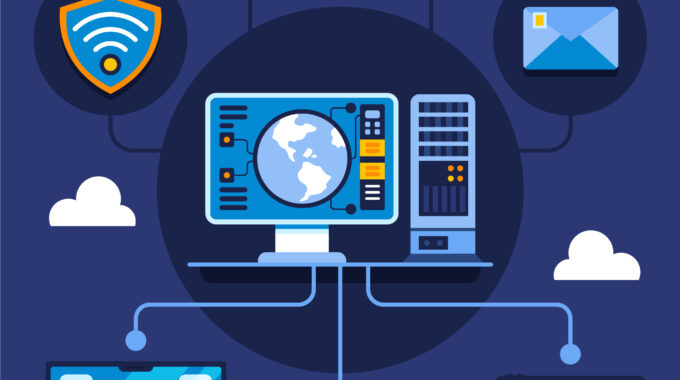Introduction To remain competitive in today's corporate environment, efficiency, speed, and precision are essential. Point-of-sale…

How POS Systems Can Improve Customer Experience
Introduction
In the dynamic realm of business, the client experience holds paramount importance. Success in any business, be it a little café, an internet store, or a major retail chain, revolves around maintaining a happy and contented customer base. A contemporary Point of Sale (POS) system is among the best instruments for improving the customer experience. But in what precise way can a point-of-sale system contribute? To better appreciate how these tools can actually improve the consumer experience, let’s look at a few in-depth instances.
1. Speeding Up Transactions: Because Nobody Likes Waiting in Line
Envision entering your preferred coffee shop during the morning bustle. You’re concerned that you’ll be late for work because of the lengthy line. But then you notice that the barista is utilizing a sleek, contemporary point-of-sale system that processes orders rapidly, which explains why the line is moving quickly. You swiftly pay with a tap of your phone, grab your coffee, and head out the door.
This is the capability of an expeditious point-of-sale system. It expedites the checkout process, reducing wait times. Whether you’re at a pop-up event or a store, mobile point-of-sale (POS) devices, integrated payment processing, and barcode scanning all enable quick transaction completion. In addition to increasing customer satisfaction, this speed enables organizations to serve more clients in less time, which increases overall sales.
2. Personalized Service: Making Customers Feel Special
When was the last time you experienced personalized service? Perhaps it was a store making product recommendations based on your previous purchases, or a bartender remembering your favourite drink. Customization is important, and a POS system can assist companies in providing it more widely.
For example, a clothes store can monitor the purchase history and preferences of its customers using its point of sale system. The salesperson may access the profile of a frequent customer and suggest new arrivals that complement their style when they walk in. Alternatively, contemplate a bookshop that provides tailored recommendations for books to read based on past purchases made by patrons. A POS system that incorporates Customer Relationship Management (CRM) functionality and stores important customer data that can be utilized to improve service makes these kind, minor gestures possible.
3. Loyalty Programs: Encouraging Repeat Visits
Integrating loyalty programs with your POS system makes managing them easier than ever. Loyalty programs are a great way to keep customers coming back. Assume you own a small bakery and would like to give your loyal customers a complimentary pastry after ten purchases. You can track every customer’s transactions with a point-of-sale (POS) system and let them know when they qualify for rewards.
This not only makes things easier for the company and the client, but it also produces a smooth experience that promotes loyalty. The POS system handles all of the work behind the scenes, so customers don’t need to remember to announce their involvement in the program or carry around physical punch cards.
4. Real-Time Inventory Management: Keeping Shelves Stocked with What Customers Want
Imagine searching a store expressly for a product and discovering it is sold out. Isn’t that annoying? By providing real-time inventory tracking, a contemporary point-of-sale system aids in averting this situation.
A small electronics store, for instance, may track stock levels in real time using its point of sale system. The technology may automatically initiate a restock if a popular device is running low, making sure that the product returns to the shelves before it sells out entirely. This not only keeps customers from being disappointed but also increases sales by maintaining stock of in-demand items. Multi-location companies can also utilize the POS system to schedule transfers and check inventory at several locations, ensuring that customers can obtain what they want quickly.
5. Omnichannel Integration: A Seamless Shopping Experience Across Platforms
Consumers of nowadays shop on several platforms: they might look over products online, read reviews on their phone, and then visit a store to complete the transaction. An omnichannel POS system makes sure that this is a smooth and uniform experience.
A boutique fashion retailer, for instance, might sync inventory between its physical location and online store using its POS system. A buyer may see a dress online, put it on hold for pickup in-store, then visit the store to try it on and complete the purchase. The entire trip is tracked by the POS system, guaranteeing a seamless transaction and real-time inventory updates. Customers will find buying more convenient with this kind of integration, which also lets firms monitor sales across many channels.
6. Flexible Payment Options: Catering to Customer Preferences
A range of payment alternatives is crucial in a time when clients demand flexibility. Conventional credit and debit cards, smartphone wallets like Apple Pay and Google Wallet, and even contactless purchases are all supported by a modern point-of-sale system.
Take a busy restaurant as an example, where patrons may choose to split the amount across several payment options. This is something that a contemporary point-of-sale system can manage with easily, enabling divided payments, tipping, and expedited refund processing when needed. Customers can pay however it is most convenient for them because to this flexibility, which makes the transaction easier and more enjoyable.
7. Building Trust Through Security
Although it may not be the first thing that springs to mind when considering the client experience, security is crucial. Consumers must be assured of the security of their payment and personal information. Advanced security features, like end-to-end encryption and compliance with Payment Card Industry Data Security Standard (PCI DSS) regulations, are standard on a modern point-of-sale system.
For example, a small boutique can ensure its customers that their financial information is safe and secure whether they make a purchase in person or online. This enhances confidence and trust, two essential components of the consumer experience.
Conclusion
A contemporary point-of-sale system (POS) is a potent instrument to improve all facets of the client experience, not simply transaction processing. A POS system may improve the efficiency of your company and the satisfaction of your clients by managing inventory, streamlining checkout processes, personalizing service, and providing various payment alternatives. Purchasing the correct point-of-sale system is an investment in your consumers and, ultimately, the success of your business in the cutthroat market of today.




